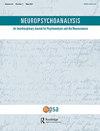Discussion of a new project for a scientific psychology
Q3 Psychology
引用次数: 3
Abstract
When Wilhelm Fliess received the amazing document from Sigmund Freud that has come down to us as the “Project for a Scientific Psychology,” he must have read it with a combination of thrill at his friend’s brilliance, frustration with its difficult and incomprehensible passages, and an impulse to advise his friend that Freud should, at minimum, include Fleiss’s nasal theories as a centerpiece of the discussion. Reading Solms’ wonderful attempt to update Freud’s Project, I find myself in a similar, though hopefully less extreme, frame of mind. While the New Project contains many points worthy of commentary and elaboration, and others points that call for clarification, I find myself coming at the entire manuscript with something like Fliess’ preoccupation with the nose, namely my own hobby horse, a central focus on nonlinear dynamic systems theory as a way of thinking about mental life. While I believe that this viewpoint is not as far off the mark as Fliess’ ideas, and while I will try to show its specific relevance to a critique of Solms’ approach, I do think it is important for myself and for the reader to keep in mind that, while the critique comes from a far better established framework than Fliess’ nasal theories, it is itself not without problems and limitations and should not be taken as gospel. The New Project is far too rich for brief discussion as a whole, so I will focus on its general approach to theory and its two foundational elements, leaving aside a vast amount of important material. Regardless of their merit as pure theory, the two projects organize vast amounts of data in a meaningful, comprehensible way. The resulting presentation of brain function could not be achieved without such an organizing conceptualization, whether or not that conceptualization is, in some sense, ultimately accurate. Both the original Project and the New Project bring together phenomena that could easily be lost among a myriad of seemingly unrelated facts and data needed to fill in the pictures they suggest. But these virtues are insufficient to make a good theory. Solms and Freud use a method that has proven fabulously successful in science – reductionism – in which complex phenomena are understood as manifestations of a small number of simple principles. Chemistry explains the properties of materials and reactions in terms of elements joined by chemical bonds; physics explains light in terms photons and their dual wave-particle nature; evolution explains the diversity of species through the mechanism of natural selection. Shouldn’t psychology be explainable in similar terms? Some history: Freud’s scientific lineage traces to Johannes Müller (1801–1858), among the last great proponents of Naturphilosophie, a tradition that included the idea that living and inanimate matter differ fundamentally. Observing that each sense organ responds to stimuli in its own particular way, Müller posited that each sense had its own specific energy. In 1826 he argued that external phenomena are perceived by changes they produce in the always active sensory system (Berrios, 2005). The eye, for example, reacts not only to light but is excited by internal sources, Imagination, with its own specific energy. In 1848, four of Müller’s students, Helmholtz, DuBois-Raymond, Ludwig, and Brücke joined in an oath to reduce biology to the forces of “equal dignity” to those of physics and chemistry and, in particular, to concepts like the conservation of energy, newly formulated by Helmholtz. No more “specific energies” or “vital forces.” Freud, who spent six years studying with Brücke, adopted this physicalist position (Galatzer-Levy, 1976). The core idea, that some quantity must be accounted for (equivalent to conservation laws of the physical sciences) in explaining phenomena being one central point, the other being that there is nothing intrinsically different about living and inanimate nature. The effectiveness of reductionism rests in its capacity to derive the properties of the whole as the sum of关于科学心理学新课题的讨论
当威廉·弗莱斯收到西格蒙德·弗洛伊德的那份令人惊叹的文件,也就是后来被我们称为“科学心理学计划”的文件时,他读的时候一定是既为他朋友的才华而激动,又为书中难以理解的段落而沮丧,同时又冲动地建议他的朋友,弗洛伊德至少应该把弗莱斯的鼻部理论作为讨论的核心。读到索姆斯对弗洛伊德计划的精彩更新,我发现自己也有类似的想法,尽管希望不那么极端。虽然《新计划》包含了许多值得评论和阐述的观点,还有一些观点需要澄清,但我发现自己在阅读整个手稿时,有点像弗里斯对鼻子的关注,也就是我自己的爱好,把非线性动态系统理论作为一种思考精神生活的方式。虽然我相信这一观点并不像弗莱斯的观点那样离谱,虽然我将试图展示它与索姆斯方法的批评的具体相关性,但我确实认为,对我自己和读者来说,记住这一点很重要,尽管这些批评来自一个比弗莱斯鼻部理论更好的既定框架,但它本身也不是没有问题和局限性的,不应该被视为福音。《新计划》内容太丰富,不能作为一个整体进行简短的讨论,所以我将集中讨论它的一般理论方法和它的两个基本要素,将大量重要材料放在一边。抛开它们作为纯理论的优点不谈,这两个项目以一种有意义的、可理解的方式组织了大量数据。如果没有这种有组织的概念化,就不可能得到大脑功能的最终呈现,无论这种概念化在某种意义上是否最终准确。“原计划”和“新计划”都汇集了一些现象,这些现象很容易被淹没在无数看似无关的事实和数据中,而这些事实和数据需要填补它们所暗示的画面。但这些优点不足以构成一个好的理论。索姆斯和弗洛伊德使用了一种在科学上被证明非常成功的方法——还原论——在这种方法中,复杂现象被理解为少数简单原理的表现。化学用化学键连接的元素来解释材料的性质和反应;物理学用光子及其波粒双重性来解释光;进化论通过自然选择的机制来解释物种的多样性。心理学不应该用类似的术语来解释吗?一些历史:弗洛伊德的科学谱系可以追溯到约翰内斯·米勒(1801-1858),他是自然哲学的最后几位伟大支持者之一,自然哲学的传统包括生命和无生命物质的根本不同。观察到每个感觉器官都以自己特定的方式对刺激做出反应,米勒假设每个感觉都有自己特定的能量。1826年,他认为外部现象是通过它们在始终活跃的感觉系统中产生的变化来感知的(Berrios, 2005)。例如,眼睛不仅对光有反应,而且还能被内部来源——想象力——用自己特有的能量激发。1848年,米勒的四名学生,亥姆霍兹、杜波依斯-雷蒙德、路德维希和布尔克联合宣誓,将生物学与物理学和化学的力量“同等重要”,尤其是像亥姆霍兹新提出的能量守恒这样的概念。不再有什么特殊的能量或重要的力量弗洛伊德花了六年时间跟随br cke学习,采纳了这种物理主义立场(Galatzer-Levy, 1976)。核心思想是,在解释现象时必须考虑到一些量(相当于物理科学的守恒定律),这是一个中心点,另一个中心点是,生命和无生命的自然没有本质上的不同。还原论的有效性在于它能够将整体的性质推导为总和
本文章由计算机程序翻译,如有差异,请以英文原文为准。
求助全文
约1分钟内获得全文
求助全文
来源期刊

Neuropsychoanalysis
Psychology-Neuropsychology and Physiological Psychology
CiteScore
2.50
自引率
0.00%
发文量
24
 求助内容:
求助内容: 应助结果提醒方式:
应助结果提醒方式:


